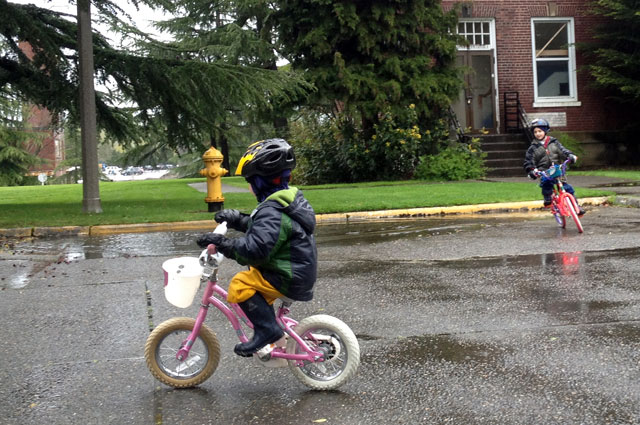
(Photos: Madi Carlson)
Hey kids, how’s it going with those new Christmas bikes? For some of us, it takes a while to get pedaling — my younger brother started riding without training wheels long before I was able to. But fear not, I have some tips for you!
➤ Remove your pedals
Turn that bike temporarily into a balance bike! Even if — actually, especially if — you’re graduating from a balance bike, your new pedal bike is going to be bigger and heavier and you’ll appreciate getting used to its heft before you need to add a new skill.
“Hey Madi, this sounds awfully familiar, haven’t you mentioned removing pedals before?”
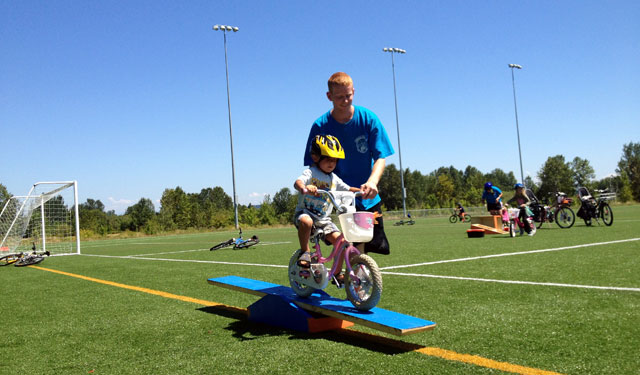
Good memory, kid! I did indeed when I spoke about balance bikes and other preludes to pedaling their own set of wheels. I also suggested that if you didn’t want to bring your bike to your local bike shop to have the pedals removed, you can DIY with a $10 consumer quality pedal wrench: your right pedal is rightly righty-tighty-lefty-loosy, but your left pedal is the opposite. So remove those pedals, lower the saddle all the way, and scoot around to your heart’s content.
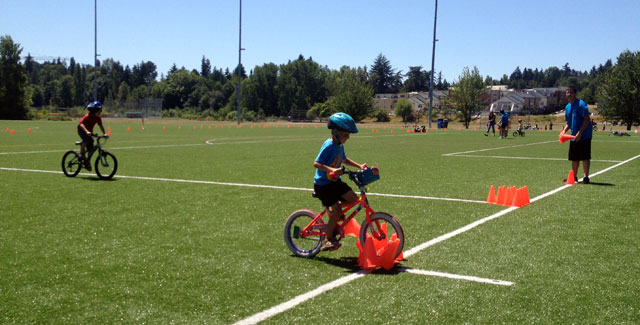
➤ Coast downhill
Once you’ve had some time to get used to pushing your bike around, put those pedals back on but don’t take to the streets or sidewalks just yet. Find a small grassy hill and coast down it with your feet on the pedals. You’ll probably want to do this a bunch of times and coast to a stop, but this is also a good time to get used to your brake(s), too. American kid bikes are required to have a coaster (foot) brake if they have wheels smaller than 20 inches so there’s a good chance that’s all you’ve got. If you’re lucky, you’ve scored a European or Canadian bike that you can backpedal, but if not, you’ll need to be careful about inadvertently pressing backwards on a pedal and coming to an unexpected stop. Your bike might also have one or two handbrakes — left hand is front wheel, right hand is back wheel, and bikes with only one handbrake can come either way, front or back.
Advertisement
➤ Coast and pedal
Same hill, same start, but pedal once you’re near or at the bottom to keep your momentum going a bit longer. You’re biking now!
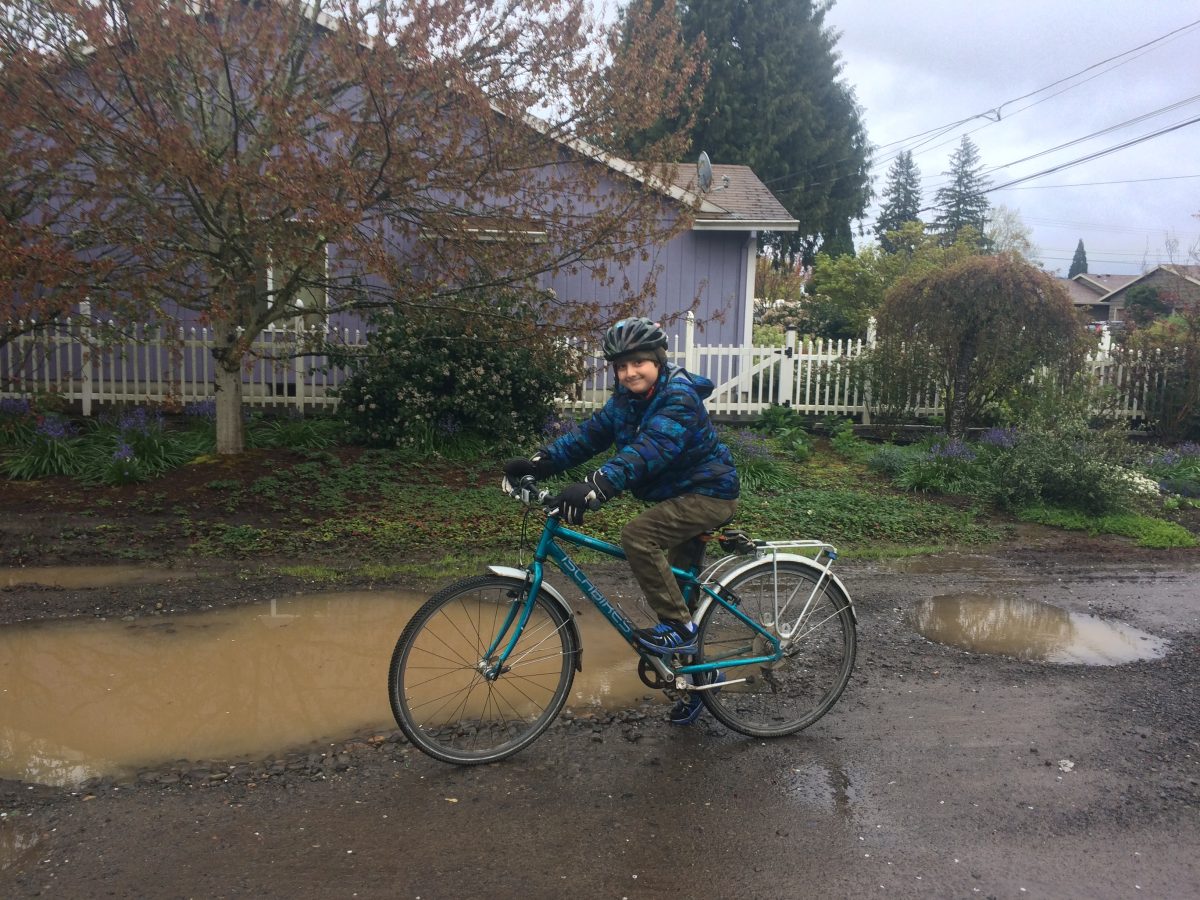
➤ Get off the grass
Grass is fun to coast down and it’s less scary than asphalt or pavement, but it’s kind of hard to pedal on, right? You’re ready to move to flat firm ground now. Getting started is the hard part so you might want a push from an adult to get your momentum going the first few times, but with or without an assist, make sure your foot of choice is in the “power position,” about 45 degrees from the top, ready to push forward.
➤ Add training wheels
Wait, what? Yes, really, add training wheels temporarily unless you truly got the hang of using your brake(s) in the previous steps. Lots of kids like the pedaling part, but aren’t so interested in the braking part so we parents can calm our nerves if you’ll just spend a couple hours in training wheels to control your speed while you focus on getting used to those brakes. But don’t do this step until you’re really adept at pedaling, you can learn the pedaling part without the training wheels, really!
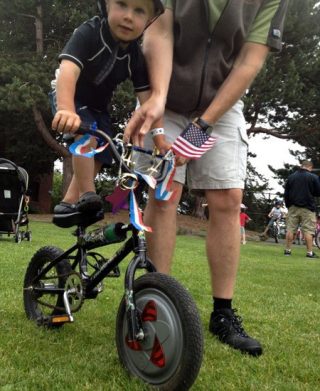
➤ Isn’t there some magical product that can help me?
Ooh, there used to be! The Gyrobike Gyrowheel gyroscopic bicycle wheel kept 12- and 16-inch bikes upright and kids quickly gained confidence to pedal without the gyro. Gyrobike’s intellectual property was acquired by a new company called Jyrobike who hoped to Kickstart a new product, but disappeared before shipping so the one Gyrowheel on eBay right now (search for gyrobike) might be the only one left.
➤ Do these steps work for adults, too?
These steps totally work for adults, too, even down to finding training wheels sized for adult bikes!
Do you have a pedaling success story to share in the comments? Or a plea for help? I’m full of advice beyond just the general steps above and I’ll be happy to answer questions in the comments. Thanks for reading!
Remember, we’re always looking for people to profile. Get in touch if it sounds like fun to you. I’d especially like to feature families of color so please get in touch or ask friends of color who bike with their kids if they’re interested in sharing their stories. And as always, feel free ask questions in the comments below or email me your story ideas and insights at madidotcom [at] gmail [dot] com.
— Madi Carlson, @familyride on Instagram and Twitter
Browse past Family Biking posts here.
Never miss a story. Sign-up for the daily BP Headlines email.
BikePortland needs your support.



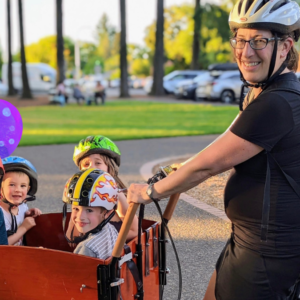
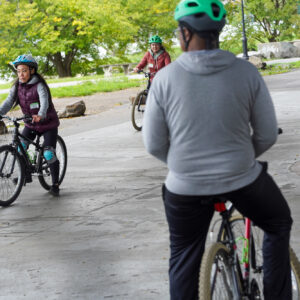

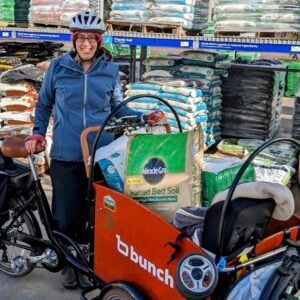
Thanks for reading.
BikePortland has served this community with independent community journalism since 2005. We rely on subscriptions from readers like you to survive. Your financial support is vital in keeping this valuable resource alive and well.
Please subscribe today to strengthen and expand our work.
We started with a balance bike and were able to transition our daughter to a 14″ non-coaster brake pedal bike without training wheels just before her 3rd birthday. One thing that I think helped a lot was setting up her new pedal bike on my indoor trainer. The rear wheel won’t engage the flywheel, but by clamping the rear brake with moderate pressure, you can create a bit of resistance. This enabled her to learn smooth pedaling and get comfortable with the bike before hitting the road. Since they already have the balancing down, adding in the pedaling confidence was all that it took. It also helps to get a balance bike with a rear hand brake. As they become more confident on the balance bike, have them pick up their feet and use the hand brake only for stopping. This is especially important if the new pedal bike does not have a coaster brake.
Using that type of indoor trainer is ridiculous. My kid will be going straight to rollers! I also would be glad to share some tips on Strava Junior….
I was having trouble with trying to get my older daughter to ride without training wheels, but the coasting-to-pedaling-down-a-small-grassy-hill is what turned a not-fun situation into one where she couldn’t stop smiling (even when she was crashing, haha)
Both of my boys were riding pedal bikes by age 3 as a result of using a balance bike. I’m a huge fan.
My son turn 3 in December, rode with pedals for the 1st time in January. We started on a balance bike, but when he outgrew the only thing we had for him was a crappy training wheels hand-me-down bike, so he used that for awhile. Got him a Woom (freewheel upgrade) in December and took the pedals off, re-acclimating him to the balance bike life. Then after a few weeks took him to a grassy field, and he was pedaling within minutes.
Besides being very physically advanced for his age, and of course the balance bike experience, I certainly think a quality bike helps a great deal. The fit and stability afforded by the right geometry is huge.
We picked up a clearance Isla CNOC 14L and got a freewheel kit from another company for $20. Voila, EU/UK style Isla for Christmas! Our 3.5 year old was a decent Strider rider and was obsessed with getting on pedals. Much to her initial dismay we removed the pedals for her to get the feel and learn the handbrakes. One thing I would add from our experience with two kids is putting just one pedal back on at first to help them get used to the downstroke and balance for stopping and starting. We skipped the grass and training wheels, but she was pedaling before the end of January. She was motivated, however, and sometimes kids just aren’t. Which is where bribery comes in. Oh, is that not what good parents do? Oops.
Totally agree with the previous comment that quality makes a huge difference especially in a first bike. We screwed that up with my older child and as a result he didn’t learn to ride until he was 8 — because at 4 he thought he hated it because he was trying to pedal a boat anchor that weighed over 50% of his bodyweight. We tried again at 8 with a nice light bike and now he’s obsessed. Live and learn…and get a balance bike.
Thanks for the post! I would add being persistent and keeping it positive. Oh, and running behind your child with your hand on the saddle so that they think they are save and then secretly stop running to see them biking by themselves without knowing it … which is hard on your back but worked for my daughter! 😉 There is something truly magical to see them ride off on two wheels, and it is so worth the effort.
Feel free to ignore my advice – whatever works, works. We teach one or two kids to ride most weeks at our Kids Saturday Bike Club and I prefer to push with my hand more or less between their shoulder blades. Using the saddle for “stealth” letting go is fine, but there is a risk that the bike will be going where you’re pushing, which may not be “quite” where they’re steering.
Whereas if you’re using the back method (and I use my fingertips) it’s a bit more flexible (course you lose the “stealth” advantage).
But balance bikes definitely the way to go (95% of the time)
Regarding whether this works for adults:
Having taught many adults to ride, I would say most of this process works for adults BUT many adults don’t deal well with crashing to learn. 😉 Also, most adults can process and use more of the theory around how bikes work. For example, it really helps to tell adults the following:
1) Look where you want to go – not down at the ground, not at the front wheel, but ahead to the horizon;
2) Bikes are more stable at speed – that means getting the bike up to 3-5mph. Before worrying about steering, the focus should be gaining confidence at coasting at that balance-sustaining speed, then steering becomes easier and more intuitive. I usually set them up in an area with no obstacles or traffic, and with a slight downhill orientation tell them to look forward and go with the bike, don’t worry about steering, go with the bike and let it coast where it wants to. Without this coaching adults will focus on riding in a straight line and that makes it much harder to achieve balance.
Additionally, adults need to learn how to use brakes earlier in the process. So, I usually teach braking before I get them coasting. This helps with confidence which in turn helps with #2.